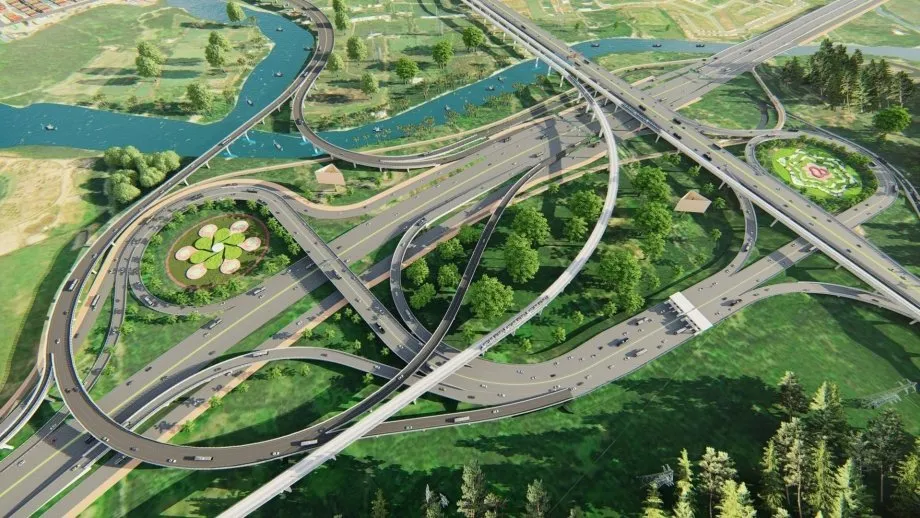
The project will cover more than 90 km of length, passing through Ho Chi Minh City, Binh Duong province, Dong Nai province, and Long An province. It has been planned with a strategic role in mind for forming a transport network to link provinces and cities in the Southern Key Economic Region. To be built with a total capital of around VND 75,300 bln, this project has the largest budget among all southern traffic projects so far.
Belt Road No. 3 in Ho Chi Minh City is divided into 8 component parts with each locality implementing 2 project parts which also include construction and site clearance. The route has six to eight lanes, and phase 1 will make 4 lanes in advance, building parallel roads on both sides.
Regional links
According to the Department of Natural Resources and Environment, the Belt Road No. 3 project passing through Ho Chi Minh City has a total compensation area of 410 hectares with 1,689 affected cases. Up to now, 4 localities have handed over more than 344 hectares, reaching 84 percent of the land. The government requires many more to hand over at least 70 percent more land. In order to achieve this result before the commencement date, the compensation and clearance work was implemented drastically by the localities, with the most beneficial policies and unit prices for the people affected by the project.
Mr. Võ Trung Trực, Deputy Director of the Department of Natural Resources and Environment, went to each household whose land was being recovered and mobilized them to agree and share with the city so that the compensation and clearance work could achieve the fastest results.
Mr. Lương Minh Phúc, Director of Ho Chi Minh City Traffic Construction Investment Project Management Board, the investor of a component part of the project in Ho Chi Minh City, said that the Ho Chi Minh City Belt Road No. 3 Project will connect 5 radial highways that include Ho Chi Minh City-Trung Luong, Ho Chi Minh City-Long Thanh-Dau Giay, Ben Luc-Long Thanh, Ho Chi Minh City-Moc Bai, and Ho Chi Minh City-Chon Thanh, creating links for the whole region.
The project will help reduce congestion, save time, and transport costs. When completed, the route will open up new spaces, form industrial corridors, connect many seaport clusters, and reduce travel time as well as logistics costs. Mr. Phúc said that the project will create a new driving force for the economy and society in the southern key economic region for more than 20 million people.
Mr. Phan Văn Mãi, Chairman of the People's Committee of Ho Chi Minh City is determined that this will be a model project on compensation and resettlement. He compared belt road No. 3 to a high-yielding chicken that lays golden eggs! This project will create a great impetus for the economic and social development of the whole region and will open a new direction for urban, industrial, commercial, and service development.
According to Mr. Mai, the exploitation of the land fund along the route after the project is completed will create a great source of revenue for the local budget to reinvest, develop transport infrastructure, create land funds, attract more investments, and develop the urban areas.
A new way to invest
This is the first time that Ho Chi Minh City has been assigned by the National Assembly, the Government, and the Prime Minister as a competent state agency to prepare projects of national importance, of such large-scale magnitude for the benefit of regional connectivity. As a focal point, Ho Chi Minh City has presided over and coordinated with Dong Nai province, Binh Duong province, and Long An province to implement the project methodically, scientifically, and strictly in accordance with the law.
The Department of Transport was first assigned by Ho Chi Minh City to be the largest project agency ever. The Department has advised that Ho Chi Minh City implement the project so as to meet progress and quality requirements.
In particular, the Department of Transport has advised and proposed new and creative ways, contributing to speeding up the project implementation. For example, developing plans and regulations on coordination between Ho Chi Minh City and localities; developing and submitting to the People's Committee of Ho Chi Minh City to issue detailed plans for the implementation of component projects within the city. Ho Chi Minh City has also established a Steering Committee for component projects and a Project Advisory Council.
In particular, the Steering Committee will be the focal point to coordinate with the Government Working Group, together with ministries and agencies to solve common problems hole project and inter-provincial issues. It can be said that the Belt Road No. 3 Project in Ho Chi Minh City is being considered a model by the Steering Committee.
Mr. Trần Du Lịch, an economic expert, said that the fact that Ho Chi Minh City was assigned to be the focal point for implementing national key projects has clearly demonstrated the plan for decentralization, as well as the role of the locality when doing large projects. In addition, the project also applies a number of specific solutions, which, if done well, can be calculated to form a common mechanism for other large projects.
From here, it is advisable to study the formation of a mechanism for exploiting the land fund associated with infrastructure construction, because if the land fund is well exploited along the route, it will create huge resources for reinvestment. With the initial favorable implementation and the mechanism approved by the people, many people expect the project to be executed on schedule.
The arterial road connecting the two regions of the East-Southwest, the North-South circulation circuit, and the opportunities that serve as a premise for Ho Chi Minh City and the Southern Economic Region to contribute more to the whole country, are expected to become a reality by 2025.




















